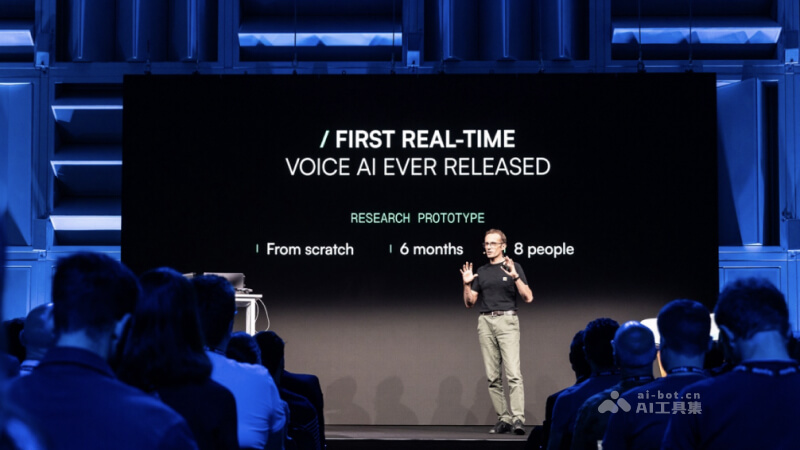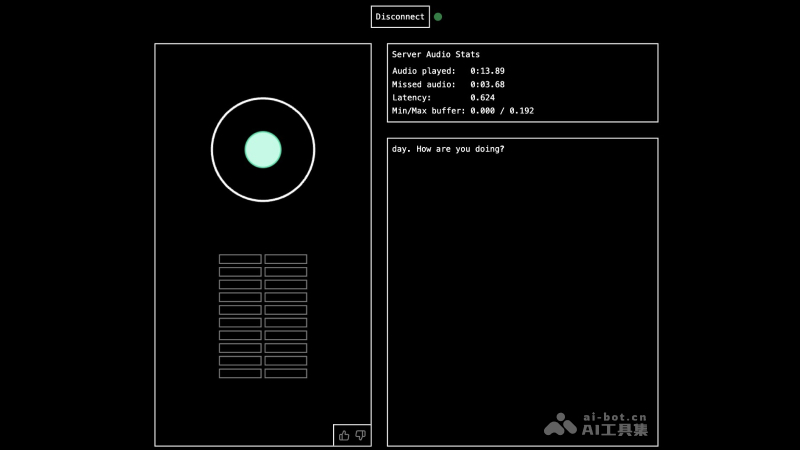Moshi
by KyutaiWhat is Moshi?
Moshi is an end-to-end real-time audio multimodal AI model developed by the French AI research lab Kyutai. It can listen, speak, and simulate 70 different emotions and styles for communication. As an open-source model comparable to GPT-4o, Moshi can run on regular laptops, features low latency, supports local device usage, and protects user privacy. The development and training process of Moshi is simple and efficient, completed by an 8-person team in 6 months. The code, weights, and technical papers of Moshi will soon be open-sourced for free use and further research by global users.
Features of Moshi
- Multimodal Interaction: Moshi can process and generate text information as well as understand and generate speech, enabling more natural and intuitive communication with users.
- Emotion and Style Expression: Moshi can simulate 70 different emotions and styles for dialogue, making AI conversations more vivid and realistic.
- Real-time Response with Low Latency: Moshi's response features low latency, quickly processing user input and providing almost instant feedback.
- Speech Understanding and Generation: Moshi can handle both listening and speaking tasks simultaneously, improving interaction efficiency and fluidity.
- Text and Audio Mixed Pre-training: Moshi is pre-trained with a combination of text and audio data, allowing the model to better capture semantic and contextual information.
- Local Device Operation: Moshi can run on the user's local device, with regular laptops or consumer-grade GPUs meeting the operational requirements.
How to Use Moshi
- Access the Moshi Platform: Visit Moshi's official website https://moshi.chat/?queue_id=talktomoshi.
- Provide an Email Address: After entering the website, simply provide an email address and click "Join queue" to start using it for free.
- Check Device Compatibility: Ensure your device (whether a phone or computer) is equipped with a microphone and speakers, as Moshi's interaction mainly relies on voice input and output.
- Start Voice Interaction: After providing your email, you can start voice interaction with Moshi, and the system will prompt you to use the microphone for voice input.
- Ask Questions or Give Commands: Ask questions or give commands into the microphone, and Moshi will understand your questions or commands through voice recognition technology.
- Listen to the Response: Moshi will generate a response based on your question and convert the text into speech through voice synthesis technology, then play it through the device's speakers.
Currently, Moshi mainly supports English and French, and does not yet support Mandarin Chinese. Additionally, the Kyutai team has stated that Moshi will soon be open-sourced, with the code, model weights, and papers being made public.
Application Scenarios of Moshi
- Virtual Assistant: Moshi can serve as a personal or corporate virtual assistant, providing voice interaction services to help users complete daily tasks such as setting reminders and searching for information.
- Customer Service: In the field of customer service, Moshi can act as an intelligent customer service agent, communicating with customers via voice, answering inquiries, and providing immediate assistance.
- Language Learning: Moshi can simulate different accents and emotions, helping language learners practice listening and speaking, and improving language skills.
- Content Creation: Moshi can generate voices in different styles and emotions, providing voice-over services for videos, podcasts, or animations.
- Assisting People with Disabilities: For people with visual or hearing impairments, Moshi can provide text-to-speech or speech-to-text services, helping them better access information.
- Research and Development: Researchers can use Moshi for research in fields such as speech recognition, natural language processing, and machine learning.
- Entertainment and Gaming: In gaming and entertainment applications, Moshi can interact with users as a character, providing a richer user experience.
Model Capabilities
Usage & Integration
Screenshots & Images


